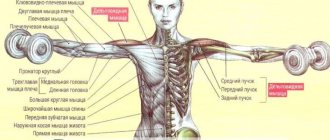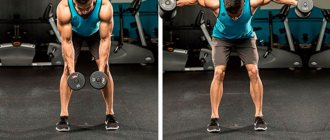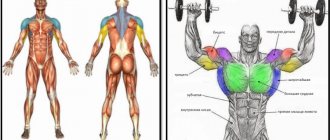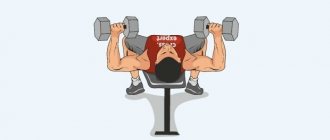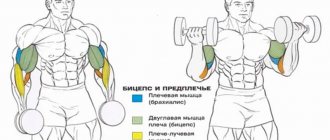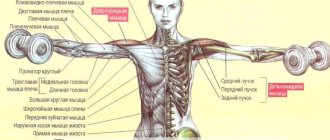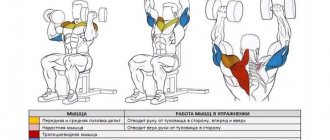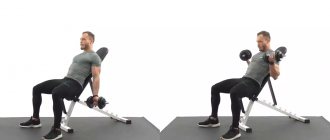No matter how they call this movement. Standing flyes, standing dumbbell abductions, standing forearms flyes, forearm abductions, standing dumbbell swings. For simplicity, we will designate it as a “standing mid-delt raise,” but it is anatomically correct to call it a lateral abduction. The number of techniques performed by athletes is even more varied. Some argue that you need to contrive to raise your shoulders and move the dumbbells in an arc. Others - under no circumstances should you lift the dumbbell above your elbow. Still others allow cheating, while others are strictly against it. Still others generally believe that the movement causes nerves to be pinched by the shoulder joint, and therefore should not be practiced. There are a lot of options, in fact, in fitness we need to master the simplest one, and not try to include “extra” muscles like the trapezius during work.
We recommend reading: Abdominal pumping at home for men
Muscle work
In this exercise, the shoulder muscles work in isolation. The main load falls on the middle or lateral deltoid bundles. Deltas are small in size and are easy to injure. Therefore, it is important to select the weights carefully when performing exercises, without unnecessary haste. Correct execution of movements is also a prerequisite.
If you do dumbbell flyes while standing or sitting with improper technique, you will overload non-target muscles and increase the risk of tears and sprains.
Common mistakes and additional trainer recommendations
Beginning athletes often make mistakes when performing training. Naturally, physical activity in such a situation does not give the desired result. For example, if a person performs a dumbbell press and tilts his torso back, swaying is observed. As a result, the maximum tension is not on the shoulders, but on the chest muscle tissue. If the thighs touch while lowering the equipment, the tone of the deltoid muscles decreases. They must always be tense during training, otherwise it will simply not be possible to achieve rapid muscle growth.
To ensure that physical activity is as effective as possible, you need to follow a number of simple recommendations:
When moving the dumbbells forward and raising them, your arms need to be slightly bent. When picking up shells, you should not try to throw them. Lowering should be done smoothly, controlling this process
Complete relaxation of muscle tissue is strictly prohibited. You should not raise your hands above your chin, otherwise the load from the deltoid muscles will inevitably shift to the trapezius muscles. When performing the exercise, you do not need to strain your core and leg muscles. It is extremely important to ensure that, when lowering, your arms are positioned symmetrically to each other. When lifting dumbbells, a fairly large number of muscles are worked out, such training allows you to achieve excellent results
The main thing is to choose the exercises that are most suitable for yourself and perform them strictly according to the rules. Also, do not forget about the need for preliminary warm-up. Only with a responsible approach to business will physical activity bring great pleasure and prove not only effective, but also safe.
When lifting dumbbells, a fairly large number of muscles are worked out; such training allows you to achieve excellent results. The main thing is to choose the exercises that are most suitable for yourself and perform them strictly according to the rules. Also, do not forget about the need for preliminary warm-up. Only with a responsible approach to business will physical activity bring great pleasure and prove not only effective, but also safe.
Vulnerability of the shoulders
Anyone who has injured the deltoid muscle at least once in their life knows why this can happen. Moreover, there are cases when a person has warmed up enough and smoothly approached the working weight (for example, in a bench press). And during one of the repetitions I felt pain.
The deltoids are not very well positioned. When moving, the tendons rub against the bones, gradually erasing their surface. This leads to inflammation of their membranes. Tears occur due to incorrect technique, poor warm-up and other violations. But the inflammation is due to such characteristics of the shoulders.
Standing dumbbell raises are also a relatively traumatic element of shoulder work. Therefore, technology is put at the forefront.
Another reason that the deltoids are most often injured is their overload.
When exercising in the gym, the deltas work during all barbell and dumbbell presses and fly-ups at all angles. Therefore, when you pump your chest, your shoulders work. You pump the triceps with the base - they do the same. You do push-ups or pull-ups - and then your shoulders come into play. In the first case, of course, more. When pulling up, the posterior deltoids are involved. In any case, spreading your hands on such days is not the best idea.
Nuances:
- Always start your work with a warm-up, first do a few movements simulating lifting your arms with weights, without weight, and then get to work.
- KEEP YOUR BACK EVEN, do not lean forward too much, otherwise you may lose your balance, and to avoid this, you will begin to help yourself with your whole body.
- Excessive bending in the elbows can lead to injury. Controlling the dumbbells at every point of the movement will protect you from dislocations and sprains.
- The exercise is performed in a single smooth rhythm. Light acceleration is allowed when lifting the dumbbells from the bottom position. By acceleration we do not mean jerk.
Rules for training deltas
In order for our shoulders to serve us longer and better, we need to adhere to certain recommendations when you do raises with dumbbells while standing (it’s better not to do it while sitting, since your legs in this position will prevent you from bringing the dumbbells together correctly):
- Dose the load. If you did bench press, flyes and other presses today, you cannot train the anterior and middle deltoids.
- If you did back exercises today, you loaded the rear deltoids. Train the front and middle buns if you want to do deltoids on this particular day.
The best way to train your shoulders is on leg day. On this day, you work purely on your legs, and you can give your shoulders a complex load, starting with a seated press and ending with standing dumbbell flyes.
Recommendations[edit | edit code]
- Perform this exercise using lower weight sets to get the most out of your rear deltoids.
- Keep your head straight, looking ahead and slightly upward to keep your back in the correct position.
- This movement is easier to perform if you do not keep your arms strictly perpendicular to your torso. By moving your arms down, you can handle more weight, but then the rear deltoids work much less effectively. It is better to use lighter weights, but raise your arms correctly.
Technique for performing dilutions
To begin with, let us remember that lifting dumbbells from the sides (raising) is aimed at strengthening and training the lateral (middle) deltoids. If you do this exercise incorrectly, the load goes to the anterior bundle. And if it’s completely wrong, then go to the back (you have to try for this).
If performed incorrectly, raising dumbbells to the sides while standing redistributes the load on the upper part of the trapezius muscles, which is not good. Dumbbell lateral raises are an isolated exercise for the lateral deltoids, and nothing else.
Before training, you need to thoroughly warm up your shoulder joints.
The technique for performing the exercise is as follows:
- Choose a place in front of the mirror, you will need to stand facing it. Take a small weight - 3-4 kg. Now we will learn how to properly swing dumbbells while standing. By the way, the correct name of the exercise is standing dumbbell raises, but it is often called flyes and swings and much more.
- Straighten your shoulders, place your feet hip-width apart. Looking directly at your face in the mirror. Bend your elbows slightly (the angle remains the same throughout the exercise) and lower them to the sides of your body. Your hands will come out a little forward because your elbows are bent.
- The dumbbells should be held so that the palms are turned towards the body. This is the starting position.
- Now attention: we begin the abduction so that the elbows are turned back and up. We raise our arms until they are parallel to the floor. Some people call this exercise "jugs" because the movement is similar to pouring water from jugs. If your elbows are not pointing up, you will not turn your arms so that water pours out of the jugs. Think of the dumbbells as jugs.
- Hold this position for 1-2 seconds and lower your arms back down.
Repeat the abduction with a light weight 10-15 times to warm up. Next, work with the necessary weights.
We do abductions of the arms without jerking, using only the force of the deltoids, without changing the angle of flexion at the elbow. We stop when our hands reach a line parallel to the floor.
Using one dumbbell
Dumbbell swings to the sides while standing can also be done with one dumbbell. When the other one is busy, or there is only one dumbbell with that weight in the gym, the one-handed option will help you out a lot. We recommend holding on to some support with your other hand to prevent unnecessary vibrations of the body.
Lateral raises of dumbbells with one hand, just like raises, are more convenient to do while standing rather than sitting.
Option with changing the position of the elbows
In any of the bent over fly variations, it is possible to change the technique, this concerns the position of the elbows when lifting. This modification will require more weight, since simplifying the technique will lead to the fact that the working weight of the classic version of the swing will be too small. This option will perfectly increase strength indicators.
- The starting point is below - arms hang down, elbows turned to the sides.
- Exhale: perform a dumbbell swing across the side, bringing your elbows to a right angle, the forearm remaining perpendicular to the floor.
- Inhale: slowly lower your arms to the starting point.
As the technique becomes easier, you can use the ladder technique, starting the first set with 12 repetitions, and with each subsequent set, reduce the repetitions by increasing the weight of the dumbbells.
Features of the exercise
Below are a number of points to consider when incorporating the exercise into your training program:
- Raising dumbbells to the sides (flying) is done with a precisely individually selected weight. If the weight is small, you will not get the effect. If it’s too big, your technique will suffer – you’ll bend your elbows even more to make the exercise easier.
- If you raise your arms with dumbbells higher than parallel to the floor, the trapezius muscles come into play. Do this if you plan to train your trapezius.
- If you swing your arms with your elbows down, the load will be distributed between the front and middle deltoids. As a result, you will not upgrade either one or the other.
- If you swing your arms cheating, for example, from a jump, it won’t do any good either. Damage tendons faster.
- Raising your arms is done while exhaling, and returning to the starting position while inhaling.
- On the last repetition, you can linger at the top point for 5-10 seconds. This will strengthen your shoulders.
- To check the technique of the exercise, do one approach, standing sideways to the mirror. Pay attention to whether you are slouching. Is your lower back arched correctly?
- For greater efficiency, you should not relax your muscles at the lowest point and lower the dumbbells onto your hips. Keep them at some distance so that the deltoids do not rest during the exercise.
- There is no wrist supination during abduction. Hands are fixed. Only the shoulders work. The hands are slightly lower than the elbows. This position will allow you to “pour the water out of the jugs” at the top point.
Bent over dumbbell swings to the sides
Isolated practice on pumping the rear head. All lifts behind the back load the deltoids, but the posterior bundle usually does not receive a concentrated load and lags behind in development. Athletes purposefully work it out on the horizontal bar or with bent over swings.
Active muscles: middle delta, rhomboid, trapezius, infraspinatus, teres minor. The technique is performed with both hands or one while standing and sitting. In the second case, you won’t be able to bend down to a clear parallel with the floor, so the load will shift to the middle head.
- IP - basic (previous). Bending at the waist, tilt the upper part of the body until it is horizontal with the floor. If the joints are flexible enough, we bend lower. A low start will “turn off” the trapezius, shifting all the tension to the deltoids.
- Keep your back slightly rounded. It is in this position that the rear head fully works.
- With elbows bent, we pull the shells up and to the sides, trying to get them further behind our back. At the end point they should not be higher than the deltoids.
- We linger in the top position for a couple of seconds, feel an intense muscle contraction, and return to the starting position.
conclusions
Dumbbell flyes are an effective exercise for pumping up the rear delts. It is better to do it after a hard, grueling workout. It is suitable for both boys and girls, and in terms of the number of repetitions it is no different from ordinary basic exercises. It is not recommended to perform it for shoulder and back injuries, but it is better to replace it with something. Particular attention should be paid to technique, since any deviation from the correct execution instantly makes it a useless exercise.
I hope you enjoyed reading the article about this wonderful exercise. In order not to get lost on the forums, you can subscribe to the newsletter and also share information with friends on social networks. That's all! I wish you good luck in your sporting endeavors.
